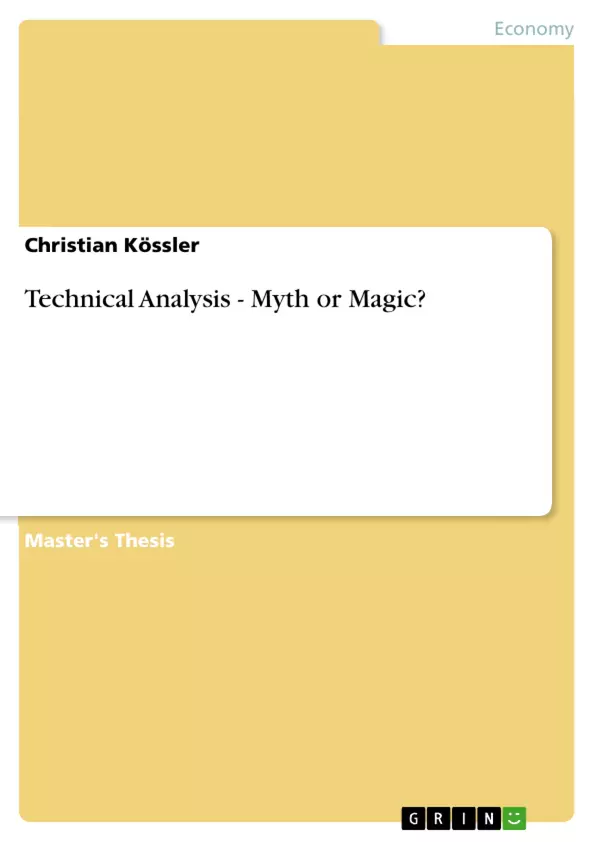Table of content
TABLE OF FIGURES………………………….…………………………………………………….…...I
GLOSSARY………………………………………………………………………………………….….....II
1. INTRODUCTION 1
2. SHARE ANALYSIS AND ITS PREMISES 5
2.1 CLASSIFICATION AND DEVELOPMENT 5
2.2 DOW THEORY IN CORRESPONDENCE WITH TA 6
2.2.1 The Averages Discount Everything (except ‘Acts of God’) 6
2.2.2 The Three Trends 7
2.2.3 The History repeats itself 10
2.2.4 Criticism of the Dow Theory 11
2.3 RANDOM WALK THEORY IN CORRESPONDENCE WITH BHS 12
2.3.1 Criticism of the Efficient Market Hypothesis 15
2.4 FUNDAMENTAL ANALYSIS 17
2.5 TECHNICAL ANALYSIS VERSUS FUNDAMENTAL ANALYSIS 17
3. METHODOLOGY 20
3.1 TEST CONDITIONS 20
3.2 TESTED INDICES 23
4. INSTRUMENTS OF TECHNICAL ANALYSIS 25
4.1 INDICATORS 25
4.1.1 Moving Averages 25
4.1.2 Moving Average Convergence Divergence 26
4.1.3 Bollinger Bands 27
4.2 OSCILLATORS 28
4.2.1 The dilemma of Oscillators 28
4.2.2 Momentum 28
4.2.3 Relative Strength Index 30
4.2.4 Slow Stochastic 31
4.2.5 Combination of Indicators and Oscillators 32
4.3 APPROACH TO PERFORMANCE TESTS 32
5. RESULTS/FINDINGS 34
5.1 BHS 34
5.2 EMA 35
5.3 MACD 36
5.4 BOLLINGER BANDS 37
5.5 MOMENTUM 38
5.6 RSI 39
5.7 SLOW STOCHASTIC 40
6. ANALYSIS 41
6.1 EMA 41
6.2 MACD 43
6.3 BOLLINGER BANDS 44
6.4 MOMENTUM 45
6.5 RSI 47
6.6 SLOW STOCHASTIC 48
7. CONCLUSION 50
8. APPENDIX 53
9. REFERENCES 71
Inhaltsverzeichnis (Table of Contents)
- 1. INTRODUCTION
- 2. SHARE ANALYSIS AND ITS PREMISES
- 2.1 CLASSIFICATION AND DEVELOPMENT
- 2.2 DOW THEORY IN CORRESPONDENCE WITH TA
- 2.2.1 The Averages Discount Everything (except 'Acts of God').
- 2.2.2 The Three Trends.
- 2.2.3 The History repeats itself..
- 2.2.4 Criticism of the Dow Theory..
- 2.3 RANDOM WALK THEORY IN CORRESPONDENCE WITH BHS
- 2.3.1 Criticism of the Efficient Market Hypothesis.
- 2.4 FUNDAMENTAL ANALYSIS.
- 2.5 TECHNICAL ANALYSIS VERSUS FUNDAMENTAL ANALYSIS
- 3. METHODOLOGY
- 3.1 TEST CONDITIONS
- 3.2 TESTED INDICES.
- 4. INSTRUMENTS OF TECHNICAL ANALYSIS..
- 4.1 INDICATORS.
- 4.1.1 Moving Averages.
- 4.1.2 Moving Average Convergence Divergence..
- 4.1.3 Bollinger Bands.
- 4.2 OSCILLATORS
- 4.2.1 The dilemma of Oscillators.
- 4.2.2 Momentum
- 4.2.3 Relative Strength Index.
- 4.2.4 Slow Stochastic.
- 4.2.5 Combination of Indicators and Oscillators..
- 4.3 APPROACH TO PERFORMANCE TESTS......
- 5. RESULTS/FINDINGS
- 5.1 BHS.
- 5.2 EMA.
- 5.3 MACD..
- 5.4 BOLLINGER BANDS.
- 5.5 MOMENTUM.
- 5.6 RSI.
- 5.7 SLOW STOCHASTIC
- 6. ANALYSIS.
- 6.1 EMA..
- 6.2 MACD...
- 6.3 BOLLINGER BANDS.
- 6.4 MOMENTUM..
- 6.5 RSI
- 6.6 SLOW STOCHASTIC
- 7. CONCLUSION.
Zielsetzung und Themenschwerpunkte (Objectives and Key Themes)
This dissertation aims to investigate the effectiveness of technical analysis (TA) in predicting share price movements. It explores the theoretical underpinnings of TA, comparing it with fundamental analysis and the Random Walk Theory. The study employs a range of technical indicators and oscillators to test their efficacy in generating profitable trading signals. The research also considers the potential impact of market conditions on the performance of these techniques.
- The effectiveness of technical analysis in predicting share prices.
- Comparison of technical analysis with fundamental analysis and the Random Walk Theory.
- Testing the performance of various technical indicators and oscillators.
- The impact of market conditions on the efficacy of technical analysis.
- The potential for technical analysis to generate profitable trading signals.
Zusammenfassung der Kapitel (Chapter Summaries)
- Chapter 1: The dissertation introduces the topic of technical analysis and outlines its scope and objectives. It also provides an overview of the methodology used in the study.
- Chapter 2: This chapter explores the theoretical foundations of share analysis, focusing on both technical and fundamental approaches. It examines key concepts such as the Dow Theory and Random Walk Theory, providing insights into their strengths and limitations.
- Chapter 3: This chapter delves into the methodology used in the research. It describes the test conditions, including the indices used and the timeframe for analysis.
- Chapter 4: This chapter focuses on the technical instruments employed in the study, including indicators and oscillators. It examines their different applications, strengths, and limitations.
- Chapter 5: This chapter presents the results of the performance tests conducted on the technical indicators and oscillators, showcasing their effectiveness in generating trading signals.
- Chapter 6: The final chapter analyzes the findings, providing insights into the efficacy of technical analysis and its potential for generating profitable trading signals.
Schlüsselwörter (Keywords)
Technical analysis, fundamental analysis, Random Walk Theory, share prices, trading signals, indicators, oscillators, Dow Theory, market conditions, profitable trading, efficient market hypothesis.
- Citation du texte
- Christian Kössler (Auteur), 2010, Technical Analysis - Myth or Magic?, Munich, GRIN Verlag, https://www.grin.com/document/163846



